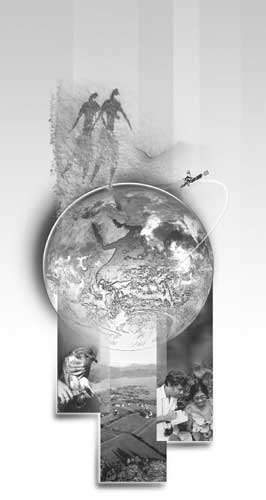


UNESCO's Man
and the Biosphere
Programme -
addressing forest
biodiversity
P. Bridgewater
Peter Bridgewater is the Secretary of
UNESCO's MAB Programme.
The United Nations Educational, Scientific and Cultural Organization (UNESCO), by the nature of its focus, has an integrated approach to issues related to land and water management. UNESCO's Man and the Biosphere (MAB) Programme has over its 30 years of existence developed the World Network of Biosphere Reserves, designed to serve as "living laboratories" for integrated work in three areas: conservation of the full hierarchy of biodiversity, economic development that is socio-culturally and ecologically sensitive, and logistic support to research, monitoring, education and information exchange. A zonation system consisting of a core area, a buffer zone and a transition area is applied to accommodate different types and intensities of human use. The World Network of Biosphere Reserves is now formally recognized and is an operational structure for facilitating exchange of information and new ideas and for training and awareness-raising. As of January 2002, there were 411 biosphere reserves located in 94 countries around the world, of which about one-fifth (corresponding to over 150 millon hectares) consist predominantly of forest systems.
The World Network of Biosphere Reserves addresses forest biodiversity in a number of ways:
- It enhances protection by encouraging protected area authorities responsible for core areas to reach out to the lands and people outside formal park boundaries to devise alternative incomes for people in buffer zones and transitional areas, thus easing human pressure on the core areas. Examples include the introduction of small-scale irrigation to improve rice production, apiculture and sale of crafts by women's groups in the Mananara Nord Biosphere Reserve in Madagascar; and enrichment planting of commercial Pinus stands with local tree species used for medicinal and other purposes, domestication of locally esteemed non-timber species and training and employment of young people from adjacent villages as guides for visitors in the Sinharaja Biosphere Reserve in Sri Lanka.
- It extends protection to entire forest ecosystems, for example by linking up the remnants of the Atlantic Forest in Brazil through a system of biological corridors. The vast 29 million hectare biosphere reserve provides a framework for co-management by a multitude of institutions at the federal, state and local levels. On a lesser scale, the East Carpathians Transboundary Biosphere Reserve provides a means by which Poland, Slovakia and Ukraine can cooperate under neutral UN designation to conserve and manage the forest systems across their frontiers. There is increasing interest to create transboundary biosphere reserves in many parts of the world.
- It draws attention to the need to conserve forest genetic resources, for example the wild gene pools of economically important forest species, such as Pinus koraiensis in the Fenglin Biosphere Reserve in China, or wild fruit-trees in many biosphere reserves in the Russian Federation and Central Europe.
- It promotes adjustment of forestry practices to take account of forest biodiversity and the numerous services and products that it provides. One example is the Clayoquot Sound Biosphere Reserve on Vancouver Island, Canada, once a crisis spot of conflicts between the logging industry and environmental activists, coupled with a social movement seeking enhanced status and livelihoods for the indigenous people. Compromises have now been reached, but they pose new challenges. The biosphere reserve approach is being used to create job opportunities and to create a forest management structure that takes account of the multiple interests, and to forge new alliances between the public and private sectors.
- It enhances sustainable management of native forests by traditional dwellers. Examples include the sustainable extraction of allspice, chicle and xaté in the Maya Biosphere Reserve in Guatemala, and the production of valuable oil from the Argania spinosa woodlands in the Arganeraie Biosphere Reserve in Morocco. The biosphere reserve status ensures the technical structure and scientific backing for sustainable harvesting and efficient marketing, and creates a moral obligation for local authorities to invest the income in the rural communities.
- It promotes basic and applied research and monitoring combining the social and natural sciences. For example, comparative studies in forest sites in the Vosges du Nord Biosphere Reserve in France are being carried out to quantify the economic and ecological advantages of applying forest management techniques that imitate nature, thus providing justification for their application in other areas. The Biosphere Reserve Integrated Monitoring (BRIM) programme encourages the collection of biotic and abiotic information using standard methods to facilitate exchanges and comparative studies, especially through the regional biosphere reserve networks.
- It is building up human capacity to address complex forest management issues, especially in developing countries. For example, in 1999, UNESCO-MAB created the Regional Post-graduate Training School on Integrated Tropical Forest Management at the University of Kinshasa, Democratic Republic of the Congo, with the support of the United Nations Development Programme (UNDP), the European Union and several donor countries. This is the only school of its kind in Africa. Practical fieldwork is undertaken in neighbouring African biosphere reserves. Also, since 1989, MAB has conferred some ten MAB Young Scientist Awards each year - of which many concern forest biodiversity.
In summary, the World Network for Biosphere Reserves is an operational structure for promoting action and exchange of experience in the conservation, sustainable use and benefit sharing of forest biodiversity. It thus helps countries to meet their obligations under the Convention on Biological Diversity.
More information on the MAB Programme and the World Network of Biosphere Reserves can be obtained on the Internet (www.unesco.org/mab) or from the Division of Ecological Sciences, UNESCO, 1 rue Miollis, 75732 Paris Cedex, France; Fax +33 1 4568-5804.

Biosphere reserves: special places for people and nature
- UNESCO



